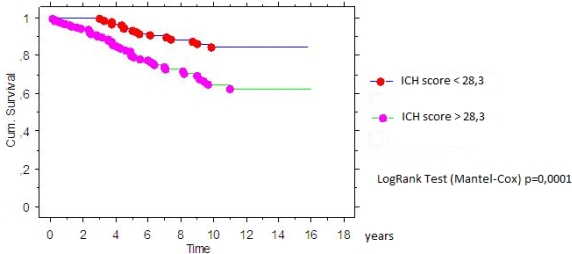Integrated Clinical-Histological (ICH) Score System for the Evaluation of “Marginal” Donors in Kidney Transplantation
1Department of Emergency and Organ Transplantation, Nephrology, Dialysis and Transplantation Unit, University of Bari, Bari, Italy
2Department of Medical and Surgical Sciences, Nephrology, Dialysis and Transplantation Unit, University of Foggia, Foggia, Italy
3Department of Emergency and Organ Transplantation, Andrology, Urology and Renal Transplantation Unit, University of Bari, Bari, Italy.
Meeting: 2015 American Transplant Congress
Abstract number: B86
Keywords: Allocation, Graft survival, Kidney transplantation
Session Information
Session Name: Poster Session B: Kidney and Donor Evaluation/Utilization
Session Type: Poster Session
Date: Sunday, May 3, 2015
Session Time: 5:30pm-6:30pm
 Presentation Time: 5:30pm-6:30pm
Presentation Time: 5:30pm-6:30pm
Location: Exhibit Hall E
INTRODUCTION: The organ shortage has led to increase the procurement of kidney from “marginal” donors and to improve the strategies to better evaluate the quality of these organs. The aim of this study was to identify an integrated clinical-histological (ICH) score that might improve the allocation of organs derived from marginal donors.
PATIENTS AND METHODS: In a retrospective study, we analyze 326 recipients of single kidney transplantation from deceased donors, randomized in a Training Set (n°= 120) and a Test Set (n°=206). We correlated clinical and histological variables with the glomerular filtration rate (GFR) at 12 months by linear regression in the Training Set; variables with p<0,05 were included in a multivariate analysis.
RESULTS: The variables that statistically correlated with the 1-year renal function were donor age and total histological score (p< 0,05). Therefore, we defined an ICH score using the coefficients obtained by regression model: Score= (donor age x 0,5) + (total histological score x 3,4). Appling this ICH score system to the Test Set, the comparison of ROC curves between ICH score and the histological score showed a significant difference and ICH score was the most accurate (comparison between AUC = 0,099, p=0,008). The ROC curve of ICH score has also defined a cut-off of 28,3 (sensitivity 86,2%, specificity 60%). Kaplan-Meier curves showed that patients with ICH score less than 28,3 have a better 10-years graft survival (85% versus 65%, LogRankTest p=0,0001). CONCLUSIONS: Our analysis show that the combination of clinical and histological data in an ICH score might significant improve the ability to allocate kidney from marginal donors.
CONCLUSIONS: Our analysis show that the combination of clinical and histological data in an ICH score might significant improve the ability to allocate kidney from marginal donors.
To cite this abstract in AMA style:
Fiorentino M, Rossini M, Gallo P, Castellano G, Schena A, Grandaliano G, Ditonno P, Bataglia M, Gesualdo L. Integrated Clinical-Histological (ICH) Score System for the Evaluation of “Marginal” Donors in Kidney Transplantation [abstract]. Am J Transplant. 2015; 15 (suppl 3). https://atcmeetingabstracts.com/abstract/integrated-clinical-histological-ich-score-system-for-the-evaluation-of-marginal-donors-in-kidney-transplantation/. Accessed December 26, 2025.« Back to 2015 American Transplant Congress
